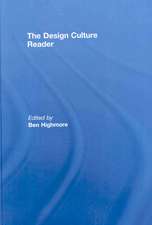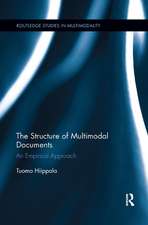Graphic Design in Urban Environments
Autor Dr Robert Harlanden Limba Engleză Paperback – 19 oct 2016
Preț: 198.69 lei
Preț vechi: 246.84 lei
-20% Nou
Puncte Express: 298
Preț estimativ în valută:
38.02€ • 39.28$ • 31.63£
38.02€ • 39.28$ • 31.63£
Carte disponibilă
Livrare economică 26 februarie-12 martie
Preluare comenzi: 021 569.72.76
Specificații
ISBN-13: 9781472597748
ISBN-10: 1472597745
Pagini: 152
Ilustrații: 64 colour illus and 36 bw illus
Dimensiuni: 169 x 244 x 9 mm
Greutate: 0.39 kg
Editura: Bloomsbury Publishing
Colecția Bloomsbury Academic
Locul publicării:London, United Kingdom
ISBN-10: 1472597745
Pagini: 152
Ilustrații: 64 colour illus and 36 bw illus
Dimensiuni: 169 x 244 x 9 mm
Greutate: 0.39 kg
Editura: Bloomsbury Publishing
Colecția Bloomsbury Academic
Locul publicării:London, United Kingdom
Caracteristici
Wide-ranging coverage of cities including London, New York, Tokyo, San Francisco and Sao Paulo
Notă biografică
Robert Harland is a lecturer in visual communication at Loughborough University, UK. Before moving into academia, he ran his own graphic design practice, Harland Design.
Cuprins
IntroductionArgumentHistoryImageabilityPatternRepresentamenConclusionBibliographyIndex
Recenzii
Rob Harland's welcome, original and ultimately provocative book considerably widens the range of objects deemed to be urban/graphic design and provides some sophisticated analytical and critical tools with which to explain those objects. If they have any sense, it will be welcomed and used by graphic/urban designers, design theorists, urban and cultural geographers, as well as town and city planners.
Robert Harland has done nothing less than redefine graphic design as a spatial practice. He shows how an intricate text of words and images mirrors the flux of people and capital through urban space. Graphic design touches nearly every transaction in the life of a city.
Graphic Design in Urban Environments shines light into the little-explored areas between architecture, urban design and graphic design. The light reveals tantalising new ways to frame discussions of how cities function, and are designed, conceived and experienced. Its audience is as broad as the subject areas it covers - urban geography, architecture, urban design, graphic design, and it offers a critical lens for reconsidering ideas of legibility and imageability in the built environment. Most interestingly, Graphic Design in Urban Environments challenges prevailing conceptions about how we experience, understand and read cities, architecture and places. The discourse has been enlivened by this engaging book.
The main discussions proposed by Harland... are original and timely. He very convincingly explains how graphic and communication design in the urban environment have been underrepresented or even ignored in graphic design historiography and in academic and educational definitions of the field, particularly in the UK. He also effectively demonstrates the difficulties faced by urban theorists who tried to describe the presence and relevance of graphic design artefacts in the public sphere, and the gaps and shortcomings of their approach. The careful descriptions and analysis presented in the book offer a framework for thinking about urban graphic interventions in multiple scales and settings. The result is a relevant contribution to design research, and should stimulate further and welcome debates on the interface between graphic design, communication, and urban design.
Graphic Design in Urban Environments should be useful to anyone interested in innovative design theory and practice.
Robert Harland has done nothing less than redefine graphic design as a spatial practice. He shows how an intricate text of words and images mirrors the flux of people and capital through urban space. Graphic design touches nearly every transaction in the life of a city.
Graphic Design in Urban Environments shines light into the little-explored areas between architecture, urban design and graphic design. The light reveals tantalising new ways to frame discussions of how cities function, and are designed, conceived and experienced. Its audience is as broad as the subject areas it covers - urban geography, architecture, urban design, graphic design, and it offers a critical lens for reconsidering ideas of legibility and imageability in the built environment. Most interestingly, Graphic Design in Urban Environments challenges prevailing conceptions about how we experience, understand and read cities, architecture and places. The discourse has been enlivened by this engaging book.
The main discussions proposed by Harland... are original and timely. He very convincingly explains how graphic and communication design in the urban environment have been underrepresented or even ignored in graphic design historiography and in academic and educational definitions of the field, particularly in the UK. He also effectively demonstrates the difficulties faced by urban theorists who tried to describe the presence and relevance of graphic design artefacts in the public sphere, and the gaps and shortcomings of their approach. The careful descriptions and analysis presented in the book offer a framework for thinking about urban graphic interventions in multiple scales and settings. The result is a relevant contribution to design research, and should stimulate further and welcome debates on the interface between graphic design, communication, and urban design.
Graphic Design in Urban Environments should be useful to anyone interested in innovative design theory and practice.








